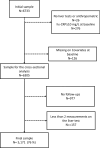Cross-sectional and longitudinal associations of Iron biomarkers and cardiovascular risk factors in pre- and postmenopausal women: leveraging repeated measurements to address natural variability
- PMID: 38715055
- PMCID: PMC11077797
- DOI: 10.1186/s12933-024-02242-x
Cross-sectional and longitudinal associations of Iron biomarkers and cardiovascular risk factors in pre- and postmenopausal women: leveraging repeated measurements to address natural variability
Abstract
Background: The association between iron biomarkers and cardiovascular disease risk factors (CVD-RFs) remains unclear. We aimed to (1) evaluate the cross-sectional and longitudinal associations between iron biomarkers (serum ferritin, transferrin saturation (TSAT), transferrin) and CVD-RFs among women, and (2) explore if these associations were modified by menopausal status.
Method: Cross-sectional and longitudinal analyses including 2542 and 1482 women from CoLaus cohort, respectively. Multiple linear regression and multilevel mixed models were used to analyse the associations between Iron biomarkers and CVD-RFs. Variability of outcomes and iron markers between surveys was accessed using intraclass correlation (ICC).
Results: After multivariable adjustment, elevated serum ferritin levels were associated with increased insulin and glucose levels, while higher transferrin levels were linked to elevated glucose, insulin and total cholesterol, and systolic and diastolic blood pressure (p < 0.05). No association was observed between CVD-RFs and TSAT (p > 0.05). Iron biomarkers demonstrated low reliability across reproductive stages but exhibited stronger associations in the perimenopausal group. In longitudinal analysis, we found association only for transferrin with lower glucose levels [β = - 0.59, 95% CI (- 1.10, - 0.08), p = 0.02] and lower diastolic blood pressure [β = - 7.81, 95% CI (- 15.9, - 0.56), p = 0.04].
Conclusion: In cross-sectional analysis, transferrin was associated with several CVD-RFs, and the associations did not change according to menopausal status. Conversely, in the longitudinal analyses, changes in transferrin were associated only with lower glucose and diastolic blood pressure levels. These differences might stem from the substantial longitudinal variation of iron biomarkers, underscoring the need for multiple iron measurements in longitudinal analyses.
Keywords: Cardio-metabolic risk factors; Cohort; Iron biomarkers; Menopause.
© 2024. The Author(s).
Conflict of interest statement
None declared.
Figures


Similar articles
-
Changes in iron measures over menopause and associations with insulin resistance.J Womens Health (Larchmt). 2012 Aug;21(8):872-7. doi: 10.1089/jwh.2012.3549. Epub 2012 Jun 25. J Womens Health (Larchmt). 2012. PMID: 22731657 Free PMC article.
-
The association of biomarkers of iron status with peripheral arterial disease in US adults.BMC Cardiovasc Disord. 2009 Aug 3;9:34. doi: 10.1186/1471-2261-9-34. BMC Cardiovasc Disord. 2009. PMID: 19650928 Free PMC article.
-
High ferritin and low transferrin saturation are associated with pre-diabetes among a national representative sample of U.S. adults.Clin Nutr. 2013 Dec;32(6):1055-60. doi: 10.1016/j.clnu.2012.11.024. Epub 2012 Dec 28. Clin Nutr. 2013. PMID: 23312547
-
Utility of iron biomarkers in differentiating menopausal status: Findings from CoLaus and PREVEND.Maturitas. 2024 Jan;179:107872. doi: 10.1016/j.maturitas.2023.107872. Epub 2023 Nov 4. Maturitas. 2024. PMID: 37952488
-
Biomarkers of iron metabolism are independently associated with impaired glucose metabolism and type 2 diabetes: the KORA F4 study.Eur J Endocrinol. 2015 Nov;173(5):643-53. doi: 10.1530/EJE-15-0631. Epub 2015 Aug 20. Eur J Endocrinol. 2015. PMID: 26294793
Cited by
-
Salidroside Improves Oocyte Competence of Reproductively Old Mice by Enhancing Mitophagy.Aging Cell. 2025 May;24(5):e14475. doi: 10.1111/acel.14475. Epub 2025 Jan 9. Aging Cell. 2025. PMID: 39789811 Free PMC article.

